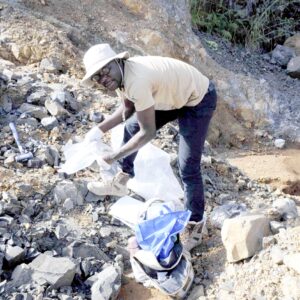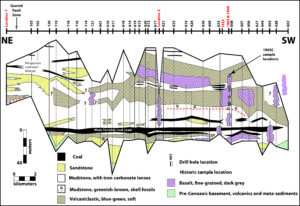In March I had the pleasure of accompanying the PhD candidate Edafe Ominigbo (School of Earth and Atmospheric Sciences, Queensland University of Technology) to Kalimantan, which is the Indonesian part of the island of Borneo.
We were there to collect mafic rocks as part of his study. I know very little about igneous petrography (I use organics to decipher palaeoclimates) but I’ve worked in this part of Kalimantan since the mid-1980s. Even back then we had noted black, mafic rocks interbedded with the Eocene sedimentary coal-bearing Tanjung Formation. Our interest was piqued but those units were not why were there, so left them for others to discover and study.

Edafe Ominigbo (PhD candidate, School of Earth and Atmospheric Sciences, Queensland University of Technology) Sampling mafic material in Petangis area, Kalimantan (Borneo), Indonesia in March 2024
After nearly 40 years these sequences were still largely unknown, with no published material on them. Enter Edafe!
Working with David Murphy, Jess Trofimovs and our colleagues at the University of Gadjah Mada (Yogjakarta, Indonesia), Ferian Anggara and Hendra Amijaya, we did some initial studies that identified these mafic units as lamprophyres.
I’m told that lamprophyres are enigmatic igneous intrusions, a characteristic that lead us to publish preliminary results (Murphy et al., 2023; https://www.ciphercoal.com/out-of-time/) on lithospheric thinning in the region. Of special interest to me, however, was the 40Ar/39Ar age dating we did, which returned a date of 37.45 ±0.1 Ma. This was the first absolute age date for these units in this region; previously there were only implied dates based on microfossils.

Cross section through East Senakin Peninsula showing Tanjung Formation with coal, mafics and other sedimentary sequences (from Murphy et al., 2024).
In the fieldwork this March we re-visited the Senakin Peninsula where our first sampling took place. But, using historic drill hole data I had saved since the 1980s (who would have thought?!) we also identified a secondary area where mafic rocks were occurring in the Eocene age Tanjung Formation.
North of the Senakin Peninsula by about 80 km, the Petangis area is a known outcrop region for the Tanjung Formation. What we didn’t know was whether there would be any unweathered outcrops of mafic material.
Luck was on our side and indeed there was! Not just unweathered outcrops but fresh quarry material. As we know, geologists in a quarry are like kids in a candy shop.
Edafe’s research will now further extend the understanding of the mafic intrusions, both in the Senakin Peninsula as well as Petangis and not only age but if they came from the same source.
To our knowledge these units are unique to the two areas. What secrets will they tell us? Well, that is for Edafe to tease out of them! Stay tuned.
Murphy, D., Moore, T.A., Amijaya, D.H., Anggara, F., Friederich, M.C., Gaina, C., Trofimovs, J., Dalton, H., Ominigbo, E., 2024. Constraints from lamprophyre petrogenesis on the timing of Eocene lithospheric thinning and associated rifting of Borneo and Sulawesi. Journal Asian Earth Sciences 260, 105952, https://doi.org/10.1016/j.jseaes.2023.105952.



Comments are closed.